Original URL: https://www.theregister.com/2012/11/01/wicked_lasers/
El Reg acquires wildly dangerous laser cannon (with lightsabre option)
Soon to be mounted on head of a shark. Or maybe donkey
Posted in Science, 1st November 2012 08:29 GMT
Once a year, El Reg's Special Projects Bureau compiles a hardware/office supplies acquisition list for the coming 12 months, which is ceremoniously laid before management in the hope the Vulture Central coffers are particularly cornucopious.
The trick is to slip in the more provocative items amid the usual litany of unremarkable items, as this extract from the 2012-13 offering shows:
- Paperclips
- Spare 500MB drive for NAS box
- Printer paper
- USB hub and cables
- Huge frikkin' laser
- Shark
- Gigabit Ethernet board for main PC
- Susbscription to New Boffin magazine.
- Coffee filters
So, did you spot the two items which didn't make it past the finance soviet? That's right, so it was straight on the blag and after a few emails to international shark dealers and Goldfinger-style laser suppliers, we'd at least got a bit closer to realising our dream of a laser-armed shark offensive capability.
Cue a delivery from Wicked Lasers, which heard our call and very kindly sent over a couple of its Spyder III models, in Krypton Green and Arctic Blue flavours.

The Spyder III is proclaimed the planet's "most advanced and powerful handheld laser", and the Arctic version caused a bit of a rumpus a couple of years back. One shaken laser safety expert described the beast as "horrendously dangerous", while a trembling Trading Standards operative confessed she was "seriously concerned about the sale of these products which should only be for industrial use".
Well, before we could get down to some hideously risky non-industrial experimentation, we had to unpack the rest of the kit, which included safety specs, rechargeable Lithium battery and an "expanded lens kit", boasting "flashlight, focus, galaxy, flood, line and cross" options, three of which are shown below.
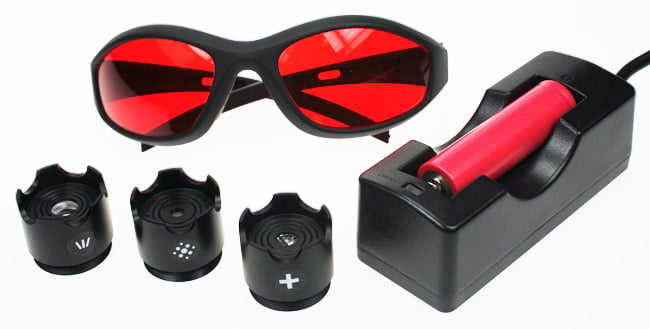
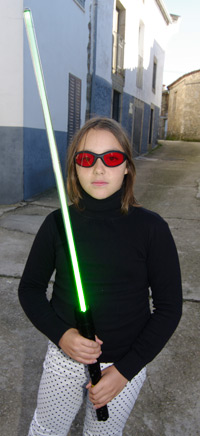 Also in the box were a couple of polycarbonate "LightSaber" blades, much to the delight of my daughter Katarina, although we had to wait until after dark to get the full effect.
Also in the box were a couple of polycarbonate "LightSaber" blades, much to the delight of my daughter Katarina, although we had to wait until after dark to get the full effect.
In the meantime, we had a chance to completely familiarise ourselves with the laser and its controls. The first impression is that it's a solid piece of kit, with a hefty aircraft grade aluminium body, "Mil-Spec Type III hard anodized in black".
The whole thing weighs in at roughly 420g, including the supplied holster, so it's hardly suited for corporate brainstorm laser pointer duties, but then at its full output of up to 1W, you certainly wouldn't want to be waving it around the boardroom anyway.
The Spyder III is a powerful beast indeed, so Wicked Lasers has made sure it's well secured against accidental/unauthorised use. To get the thing fired up, you have to first press the on button on the bottom (see 1, below), then input a "morse code" sequence using another button on the side (2).
It takes five clicks - three short and two long - to produce dazzling laser illumination, and as you progress, the status is indicated by one, two or three LEDS (3) in various combinations.
This process takes a bit of getting right, so it's fair to say you can't inadvertently power up a Spyder III. When you finally do get the hang of it, it takes around 10 seconds to get a low-power beam (approx 20 per cent) beam bursting from the aperture (4) in initial "strobe" mode.
Further clicks on the button switch the laser between low power continuous, high power strobe, high power continuous, SOS and beacon modes.
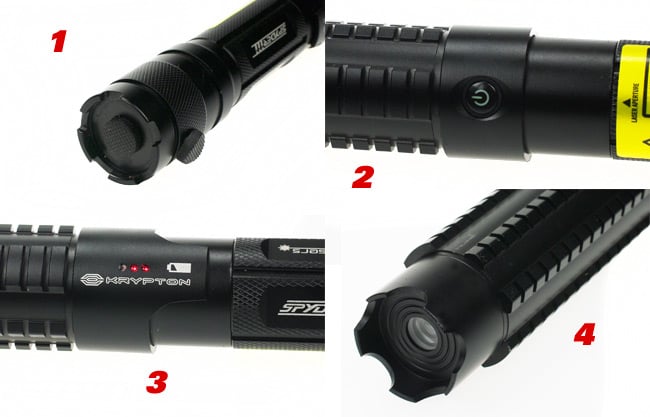
For complete peace of mind, you can disable the laser by removing the "Safety Interlock" pin seen on the side of the body in pic 1. If that's not enough for you, then unscrew the "Contact Guard" metal plate opposite the Safety Interlock and that will also render the device inoperable.
So, with the fire-up sequence mastered, and the two lasers clamped to stands, it was time for a blast:
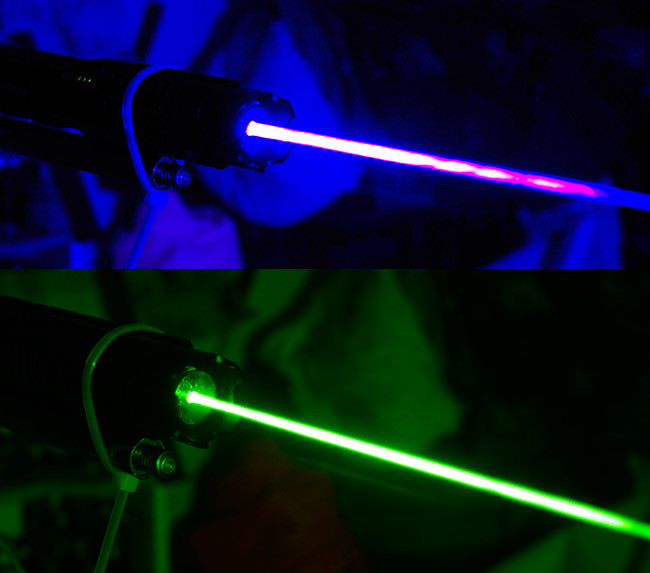
The output of the Spyder III is impressive, to say the least. So impressive, it's important to make sure you have the safety glasses on at all times, since even looking the beam's dot against a white wall will have you seeing spots for some time afterwards. It's particularly important to take care with the Arctic, whose 445nm wavelength poses a particular risk to eyes.
According to Wicked Lasers, the Arctic's Nominal Ocular Hazard Distance (NOHD) - "the distance that a laser beam does not cause immediate or long term damage to a person ... based on a 0.25 second accidental (unaided eye) exposure" - is 149m at a power output of 1W.
The beam has a power of 0.25 lux at 6,856m, according to the blurb, which notes that this is "the standard that flashlights are measured against", namely the FL1 Standard for beam distance.
By comparison, a substantial Maglite 3-Cell D flashlight's FL1 is 364m.
For real penetration, though, check out the stats on the 532nm green Krypton. At full power, its NOHD is the same as the Arctic - 149m. However, its FL1 is a staggering 137,120m.
This extra penetration is offered by the Krypton's tight 2mm diameter beam, compared to the Arctic's 2mm x 5mm spread. That's reflected in the price difference between the two models, as you can see on Wicked Lasers' website.
Here are a few examples of Krypton output via bits from the expanded lens kit. You can see (clockwise from top left): the supplied dust cover lens, projecting a tight dot, and the line, galaxy and cross.
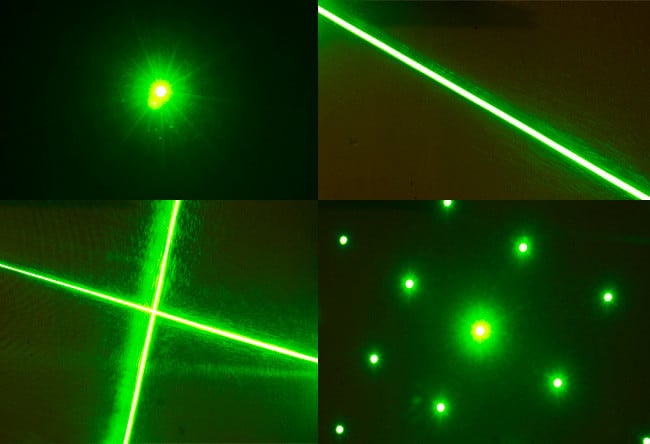
There's also a "flashlight" lens, which is a fairly tight beam diffuser, and a wider flood lens which made for some interesting illumination in this long-exposure shot:
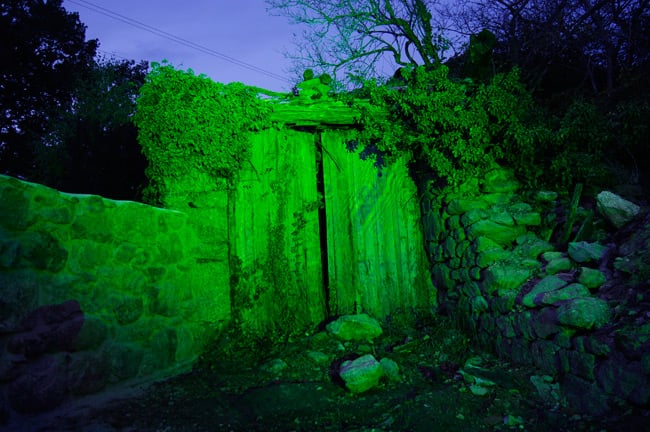
Unsurprisingly, this artistic effort didn't much impress Katarina, who was eager to indulge in some lightsabre action...
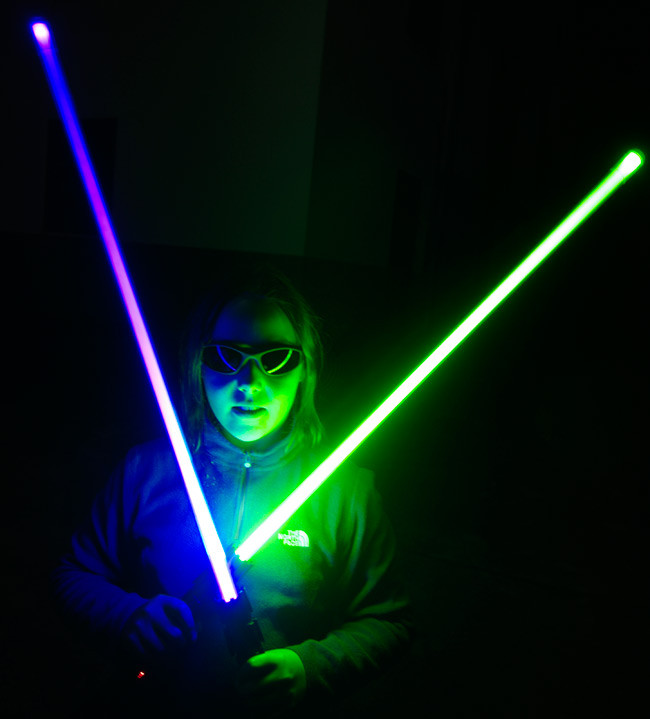
... and here she is attempting to Jedi a rift in the fabric of time and space:
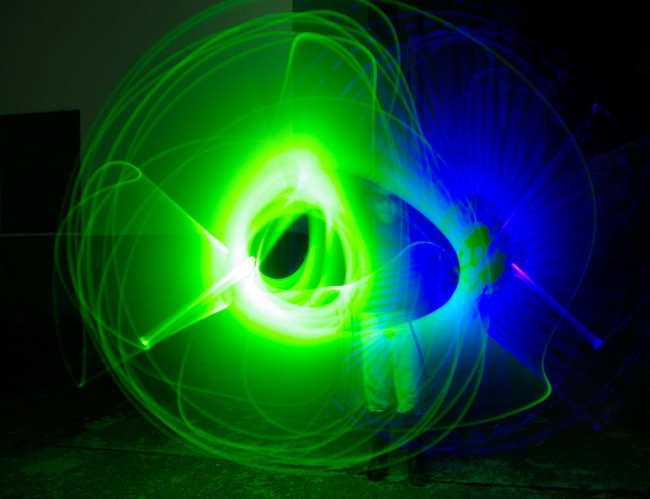
The lightsabre option is great fun for kids, and doubtless for many Reg readers who've long dreamt of battling the Empire. We, though, have other plans for the lasers.
Yes, these do include getting our hands on a shark, but we're also putting together a serious scientific experiment, details of which will be revealed in due course.
While you ponder just what cunning plan we're formulating, here's a really nice 30-second exposure of the Arctic in action, as Katarina and I attempted to melt a stone building some 30 metres away:
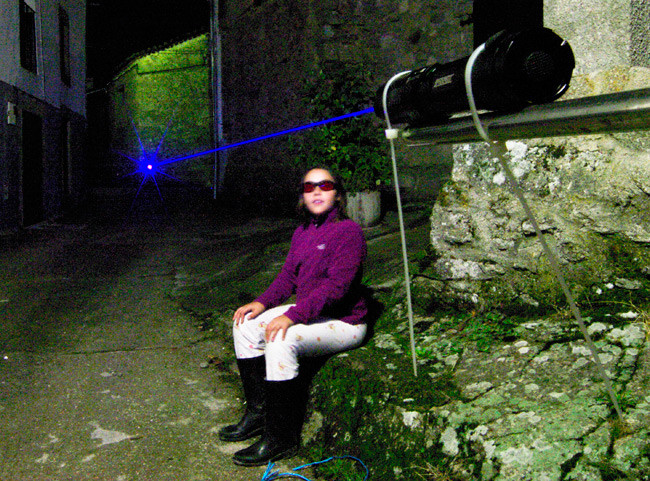
In case you're wondering, the village was pretty well deserted when we did the above test. Just in case, I had someone posted round the corner to prevent any stray local from wandering into the beam. After the health and safety shoeing I copped over the Portuguese builder in a hole outrage, I'm not taking any chances. ®